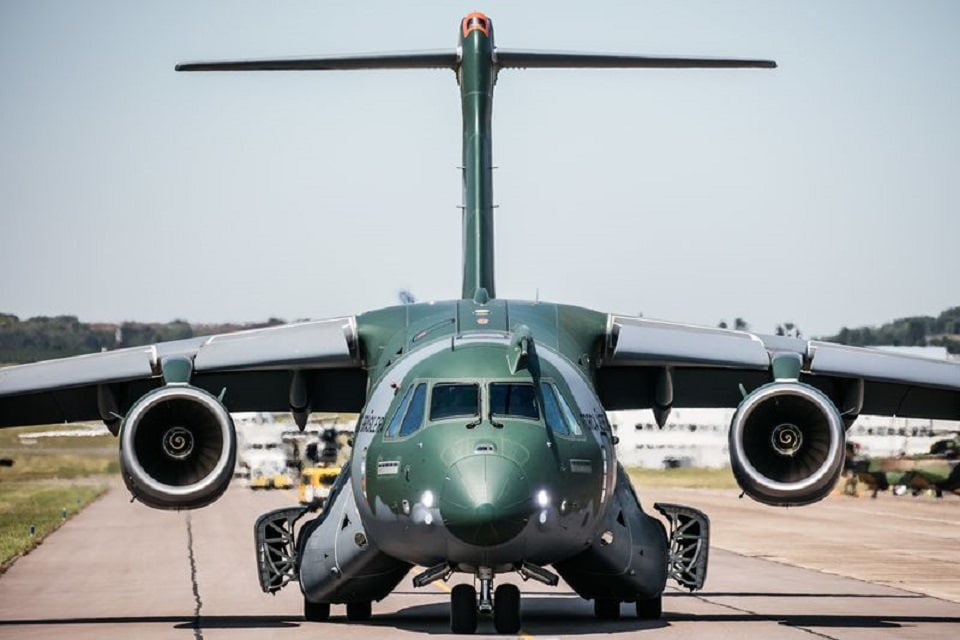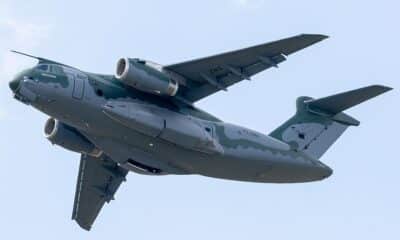Aerospace
Comparison of the Embraer KC-390 Vs the Lockheed Martin C-130J cargo plane.

In this article, we going to compare the Embraer KC 390 and Lockheed Martin C130j, Both aircraft are majority used for military transport purposes. 130J was introduced in the year 1999 and the Embraer KC 390 in 2019, it is the largest aircraft ever built by Embraer.
The KC-390 was meant to compete with the Lockheed Martin C-130J Super Hercules on the military tactical air lifter market, and it provides stiff competition for its American counterpart. When compared to the C-130J, the KC-390 is predicted to be 15% faster, carry 18% greater cargo, and cost 41% less to purchase.
Despite having a 15% lower range than the C-130J, the KC-390 includes aerial refueling as a standard feature (only a few specialized sub-variants of the C-130 have an aerial refueling capability).
Lockheed Martin C-130J
The Lockheed Martin C-130J Super Hercules, which was introduced in 1999 and has four turboprop engines, is mostly used as a military transport aircraft. The Lockheed C-130 Hercules, which originates from US states, has received a full upgrade with the C-130J that contains new engines, a flying deck, and other equipment.
The C-130J is the only model of the C-130 Hercules that is currently produced. Recently in March 2022, the 500 C-130J aircraft were delivered to 26 operators in 22 different countries.
The Royal Air Force [RAF] of the United Kingdom has given it to launch the J-model. Before delivery might occur, Lockheed Martin’s contracts with some future customers, including the United States Air Force (USAF) and the Royal Australian Air Force, were pursued.
This has to be done to speed up the sale of the military and commercial versions of the aircraft. Lockheed Martin had spent over US$900 million in development costs for the C-130J.
The USAF and USMC have made extensive use of the Super Hercules in Iraq and Afghanistan. Moreover, Canada has sent CC-130J planes to Afghanistan. Over 1 million flight hours have been recorded by C-130J Super Hercules aircraft from 13 different countries.
A self-contained unit that can be loaded, the Modular Airborne Firefighting System (MAFFS) is used for aerial firefighting . That can be loaded onto a C-130 Hercules, which then allows the aircraft to be used as an air tanker against wildfires.
The United States Air Force is currently the largest operator of the C-130J, having placed increasing quantities of orders for the aircraft. 500 units had been created overall as of March 2022.
It operates in many nations, like Algeria, Australia, Bangladesh, Canada, Denmark, France, Germany, India, Oman, Qatar, and Saudi Arabia… It can carry 92 passengers and has a maximum takeoff weight of 155,000 lb (70,307 kg).
KC390
The EMBRAER KC-390 took to the skies for the first time in 2015. The first deliveries to the Brazilian Air Force were supposed to commence in 2016. Despite the fact that these plans have been postponed until 2018,
The horizontal stabilizer is installed on top of the vertical stabilizer in an “all-flying tail” T-shaped layout on military cargo aircraft. The cargo hold can hold up to three cars, each weighing up to 23 metric tonnes.
The Embraer C-390 Millennium is a medium-sized, twin-engine, jet-powered military transport aircraft. It was made by the Brazilian aerospace company Embraer and it has a carrying load capacity of 26 tons [57000 Ib].
The aircraft can be designed to accomplish a variety of traditional operations, including troop, VIP, and cargo transportation, as well as more specialized logistical operations, like aerial refueling as a tanker. It is the company’s heaviest airplane to date.
The first production aircraft was delivered to the Brazilian Air Force on 4 September 2019. During the Dubai Airshow, Embraer announced the aircraft’s new name for the global market, C-390 Millennium.
Embraer intended to use the closed-loop fly-by-wire, synthetic vision, and rear ramp of the mature Embraer 190 (E190) aircraft along with its wing and GE CF34 engine to power a cargo hold cabin. With a rear ramp for loading and unloading a variety of cargo, the transport aircraft will combine many of the technological innovations featured in the Embraer E-Jet family series.
Based on the initial development of the aircraft, the Brazilian government expected to invest roughly US$33 million. The development and construction of two prototypes will cost Embraer $1.5 billion.
By 2014, seven different countries had ordered a total of 68 KC-390s. Argentina has six, Brazil has twenty-eight, Chile has six, Colombia has twelve, the Czech Republic has two, and Portugal has one (5-6).
In addition to the aircraft already ordered, the Brazilian military intends to purchase another 100. France also intended to buy 12 KC-390s. Embraer offered KC 390 aircraft to India, which is currently served by Russian-built AN 32, IL76, Boeing C17, and C130J Hercules.
C130J
It is a four-engine turboprop military transport aircraft.
The First flight was introduced in 1996.
It is manufactured by Lockheed Martin.
National origins from the United States.
In May 1998, Lockheed had spent over US$900 million in development costs for the C-130J.
The C-130J’s cargo compartment is approximately 41 feet (12.5 m) long, 9 feet (2.74 m) high, and 10 feet (3.05 m) wide, and loading is from the rear of the fuselage.
It operates in many countries like Algeria, Australia, Bangladesh, Canada, Denmark, France, Germany, India, Qatar, and Saudi Arabia.
KC390
It is a twin-engine, jet-powered military transport aircraft.
The First Flight was introduced in 2019.
It is manufactured by Embraer Defense Security.
National origins from Brazil.
On 14 April 2009, Embraer was awarded with a $1.5 billion contract to develop and build two prototypes
Embraer built the C-390 around the 18.5 m (61 ft) long, 3.45 m (11.3 ft) wide, and 2.95 m (9 ft 8 in) high hold with a rear ramp.
It operates in some countries like Brazil, Hungary, Netherlands and Portugal.

Aerospace
Indigo will soon launch Air Taxi Service in India

InterGlobe Enterprises, the parent brand of IndiGo, is set to revolutionize travel in India with its upcoming air taxi service.
Scheduled for a potential launch in 2026, this innovative venture promises a seamless journey for passengers between two bustling hubs. Delhi and Gurgaon in Haryana. The forthcoming service is projected to revolutionize the daily commute, offering passengers a swift aerial journey covering the distance in a mere 7 minutes.
This remarkable efficiency contrasts starkly with the conventional 90-minute drive, underscoring the immense time-saving potential for commuters. The anticipated fare, ranging from Rs 2,000-3,000, makes this innovative mode of transport not only swift but also remarkably competitive in pricing.
At the heart of this ambitious endeavor lies a strategic partnership with Archer Aviation, a pioneer in electric vertical takeoff and landing (eVTOL) aircraft technology. Under this collaboration, Archer will supply 200 state-of-the-art eVTOL aircraft, representing an investment of US$ 1 billion. These cutting-edge aircraft, capable of accommodating up to four passengers alongside the pilot, epitomize the future of sustainable air travel.
Powered by six battery packs, Archer’s eVTOL aircraft boast rapid charging capabilities, enabling a swift turnaround between flights. With a charging time of just 30-40 minutes, these eco-friendly aircraft ensure minimal downtime, maximizing operational efficiency.
Similar services are anticipated to be introduced by the joint venture in Bengaluru and Mumbai as well. Nevertheless, the service rollout period has not yet been made public by the company. Next year, it is anticipated to get its certification. Following this, the company will start the certification procedure with the Directorate General of Civil Aviation (DGCA).
Aerospace
Which is bigger 777x or 787 aircraft ?

The 777X is a new series of the Boeing 777 family and is designed to be larger and more efficient than its predecessor. It features two variants: the 777-8 and the 777-9, being the larger of the two.
The Boeing 777X emerges as the larger sibling within the Boeing family, representing a significant leap forward in both size and efficiency. Comprising two variants, the 777-8 and the 777-9, the latter takes the crown as the larger of the two. With its expansive fuselage and impressive wingspan, the 777X is tailored for long-range journeys and boasts a substantial passenger capacity.
On the other hand, the Boeing 787, affectionately known as the Dreamliner, occupies a niche in the market as a smaller yet formidable aircraft designed for medium to long-range flights. Its distinguishing feature lies in its composite fuselage, a technological marvel that renders it lighter and more fuel-efficient compared to conventional aluminum counterparts. The Boeing 777X is larger than the Boeing 787 aircraft.
When it comes to passenger capacity, the 777-9 reigns supreme, typically accommodating a sizeable contingent of 400-425 passengers in its standard configuration. In contrast, the 787, with its more modest dimensions, typically carries between 240-290 passengers, depending on the variant and layout.
One of the remarkable innovations introduced with the 777X is its folding wingtips, a feature designed to address the logistical challenges of accommodating such a large aircraft in conventional airport gates. These folding wingtips enable the 777X to retract its wings, allowing it to fit into gates designed for smaller aircraft while still reaping the benefits of an extended wingspan during flight, thereby enhancing fuel efficiency and operational flexibility
Aerospace
China Secures Production Certificate for Mass Production of Pilotless eVTOL Aircraft

The first passenger-carrying pilotless electric vertical takeoff and landing (eVTOL) aircraft in the world, the EH216-S, has received the Production Certificate for its eVTOL aircraft from the Civil Aviation Administration of China (CAAC).
This is a significant milestone for EHang Holdings Limited, the leading UAM technology platform company in the world. This outstanding accomplishment is another big step towards mass manufacturing for the eVTOL aircraft and the ensuing commercial operations, building on the ground-breaking acquisition of the Type Certificate and the Standard Airworthiness Certificate for the EH216-S.
The PC is a crucial certificate that the aircraft maker receives from the CAAC, the country’s aviation authority. By obtaining this certificate, EHang has demonstrated that it has set up a quality management system for mass production that satisfies the airworthiness regulation standards set forth by the CAAC, and the company has been given permission to continue producing mass quantities.
It is also a strong guarantee of the calibre of the goods made by EHang. Raw materials, supplier management, manufacturing organisation, production quality control, aircraft pre-delivery test, after-sales repair and maintenance, etc. are all included in the mass production quality management system for the EH216-S.
To ensure that every aircraft and its components that roll off the production line strictly adhere to the approved type design and safety requirements, the system sets clear guidelines and documentation for every step in the production procedure. This ensures comprehensive traceability and safety control.



























